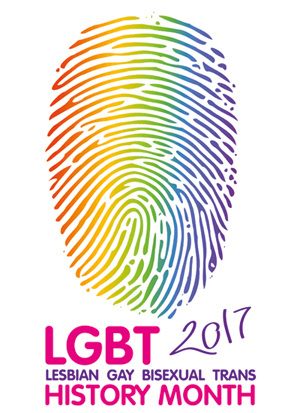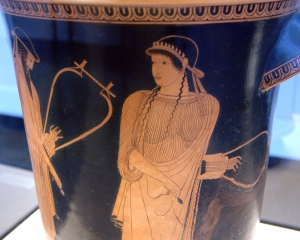February is LGBT History Month, and importantly 2017 marks the 50th anniversary of the partial decriminalisation of male homosexuality, which makes this a great time to have a look at some of the object histories that may have been marginalised within museum culture.

In today’s post, Shaun, Visitor Team Co-ordinator at Manchester Museum, takes a look at same-sex desire in the Spartan and Athenian cultures. But first, a brief look at some of the changes in the ways that object histories have been represented in museums.
And for more about our archaeology collection, have a look at the curator’s blog, Ancient Worlds at Manchester Museum.
****
The representation of same-sex desire and fluid ideas of gender have all too often been considered inappropriate, with museum interpretation focusing rather on aesthetics (Osborne, 2004, “Greek History”), technical production, and chronology, rather than the social history of these objects.
It is only in recent years that there has been a conscious drive to acknowledge the diversity, and celebrate the queerness of many historical objects. This historiographical approach is an important part of recognising diversity in the twenty first century; it challenges the traditionally projected assumptions about gender, sex and heterosexual desire, as well as the privileges afforded in interpretations and display of the nuclear family as the default model for society.
 Even natural history dioramas have reflected the normalised family groupings, typically with the male in an elevated position, and the female caring for the young. (Image from the Smithsonian National Museum of Natural History)
Even natural history dioramas have reflected the normalised family groupings, typically with the male in an elevated position, and the female caring for the young. (Image from the Smithsonian National Museum of Natural History)
The archaeology of the past is by nature fragmentary, and the residue of emotion is not necessarily retrievable within these material traces. Additionally, the reception of cultural conventions very often reflects more the Western cultural norms at the point of excavation or collection, making access to conventions of the source communities problematic.
“Much of the historical evidence is centred around men and their concerns and often what survives is partial, fragmentary or ambiguous. Such things have often been hidden in history, and obscured by censorship, but now we realise the past is much ‘queerer’ than we have often thought.”
– British Museum
Although ‘homosexuality’ is a relatively modern term, same sex-desire has precedents in ancient cultures from across the globe, evidencing that this has always been an aspect of human experience. One of the most materially well-attested of these cultures ancient Greece. Consequently, Classical scholars have used the term ‘Greek love’ as a euphemism for homosexuality, in the analysis of the visual representation of same-sex desire in art and sculpture. This visibility in Greek art also served as an early paradigm in the campaign for the social acceptance of modern gay culture – something that has been challenged by Michel Foucault. (Blanshard, 2004, “Greek Love”)
Nevertheless, same-sex desire, especially between men, is received by a modern audience as something that was normalised by the ancient Greeks, and therefore ancient Greece offered images of a world where same-sex desire was not considered abnormal or unnatural.
 Figure of a river god, from the Parthenon, Athens dated between 438-432 BC. British Museum. (Image from: itv.com)
Figure of a river god, from the Parthenon, Athens dated between 438-432 BC. British Museum. (Image from: itv.com)
Modern European museums displaying such statuary allowed people view the naked human form in a respectable way, and let men look at naked men. However, there are many different models of the manifestation of same-sex desire in art and sculpture from ancient Greece.
Michelle Scott
****
Intimacy between men was culturally approved in some cities in ancient Greece. Much ancient Greek art displayed naked male beauty and was more likely to be seen by a male audience, and provided a focus for the sexualised male gaze. Below, Shaun looks at some of the different representations of same-sex desire in the ancient Spartan and Athenian cultures.
Spartan and Athenian Sexuality
For a modern audience, I would describe the representation of sexuality in Sparta as ‘mature’. And although the physical male-male relationships between Spartan men were akin to what we might consider as gay, the classifications of straight, bi and gay simply did not exist for them.
As the concept of sexual preference did not exist for the ancient Greeks (Dover, 1989, Greek Homosexuality), I think it is anachronistic, then, to apply the term homosexual. In Greek warlike cultures, homosocial relationships were often a part of military organisation. The Spartans accepted male pairing and segregated the men in to military barracks from as early as the age of 7, apart from women, for long periods of time. It was believed that they would fight better and harder for their male companions in that way and would defend each other. However, it was fully expected that they would be married to women and father children in the future.
 Greek amphora, with black figure decoration showing Greek soldiers, or hoplites. Manchester Museum, No.: 40088.
Greek amphora, with black figure decoration showing Greek soldiers, or hoplites. Manchester Museum, No.: 40088.
The type of male-male relationship in ancient Greece for which we have most evidence is what is known as paiderastia; this is very much the Athenian model of same sex desire. In Athens, the young, unmarried man, the erastēs, or lover, would take the beardless boy, the erōmenos, or beloved, under his wing. Both belonged to the elite class of Greek society.
 Greek kylix, the red figure decoration shows a symposium scene (Manchester Museum, No.: 40109)
Greek kylix, the red figure decoration shows a symposium scene (Manchester Museum, No.: 40109)
Although for modern commentators it is difficult to separate this from discussions about child abuse and current sexual morality (Osborne, 2004, “Greek History”), in ancient Athenian and Spartan culture it was socially acceptable for older men to be engaged in physical, sexual relationships with younger men and boys, and just as with their male-female relationships, their masculinity was defined by their dominance and the passive role of their partner. In this way, the younger boy was mentored; this allowed him to learn the social and political aspects of dominance and submission, and he retained his honour by not taking pleasure in the passive sexual act.
Left: Oinochoe decorated with scene showing Dionysus and a youthful male (Manchester Museum, No.: 41457). Right: Kotyle decorated with two naked athletes (Manchester Museum, No.: 37447)
Once he reached adulthood, he would cease to be the passive partner, and it was fully expected he would leave the older man and get married. If he was wealthy enough, he too would become an erastēs, and have boys to teach and mentor, which again included sexually.
It should be remembered that our reading of these aspects of Greek culture come from our interpretation of publicly commissioned sources – literature and material culture – and do not give us a great deal of information about people’s private lives, or emotions.
There is far less evidence for same-sex desire between ancient Greek women, but the best evidence we have come from Sparta, where, like men, a high value was placed on the relationship between respectable women and younger, unmarried girls. In Sparta, from an early age, girls learnt wrestling, gymnastics, how to fight and other demanding training. Spartans believed that strong women produced stronger children. Young women competed at athletic events and may have competed in the nude, as the men did; but other Greeks thought this to be scandalous behaviour! Although these relationships are not preserved in the material record, fragments of poetry describe the erotic same-sex desire between women.
 One of the earliest surviving images of the Greek poet, Sappho, from c. 470 BC (Image from: wikipedia.org)
One of the earliest surviving images of the Greek poet, Sappho, from c. 470 BC (Image from: wikipedia.org)
One of the most famous ancient Greek poets, for both modern and contemporary audiences was Sappho, renowned for her love poems addressed to women, including the ‘Hymn to Aphrodite’. She was the head of a thiasos, a community where young unmarried girls or women, could receive a limited form of education, as well as same-sex love with their mistresses or other students.
It is believed that Sappho was a lesbian in the modern sense, as well as the original meaning of an inhabitant of Lesbos.
– British Museum
Shaun Bennett
For more about our archaeology collection, have a look at the curator’s blog, Ancient Worlds at Manchester Museum.
And for further discussion about the representation of same-sex desire in ancient Greece have a look at;
Mark Golden and Peter Toohey (Editors). 2011. A Cultural History of Sexuality: In the Classical World
B. Parkinson. 2013. A Little Gay History: Desire and Diversity across the World
http://www.britishmuseum.org/explore/themes/same-sex_desire_and_gender.aspx
http://lgbthistoryproject.blogspot.co.uk/2014/02/ancient-greece.html
Alastair J.L. Blanshard. 2004. “Greek Love”, in Didier Eriobon, Insult and the Making of the Gay Self
Kenneth J. Dover. 1989. Greek Homosexuality
Robin Osborne. 2004. Greek History


It’s fantastic to see LGBT stories in museums. As a museum worker researching best practice I also found this very useful: https://www.museumnext.com/insight/museums-expand-narratives-with-lgbt-interpretation/
Clearly you know nothing about Sparta. I imagine life was a living hell for women, slaves and little boys in Athens and Thebes. I don’t feel sorry for Athens losing the war or the fact a bisexual teenager sewed the city of Thebes with salt. I have nothing but contempt for gay history.